Leadership and Project Management: Barack Obama's Presidency
VerifiedAdded on 2023/06/03
|10
|2100
|188
Report
AI Summary
This report examines Barack Obama's leadership, focusing on his transformational leadership style and its application in project management, particularly the implementation of the Affordable Care Act (Obamacare). The report begins with a biographical overview of Obama, followed by an analysis of his leadership traits, including charisma, effective communication, decision-making, and risk-taking. It highlights how Obama's leadership style, characterized by conviction, change-oriented attitudes, and a focus on the common good, influenced the project's success. The analysis details the impact of his leadership on the Obamacare project, emphasizing how his ability to build trust, communicate effectively, and connect with the population contributed to the project's progress. The report concludes that Obama's leadership was instrumental in the success of the project, showcasing his intelligence, authority, and authenticity in taking care of all the stakeholders involved. The report also acknowledges the criticism faced by the project, despite which Obama continued to work towards the well-being of his people.
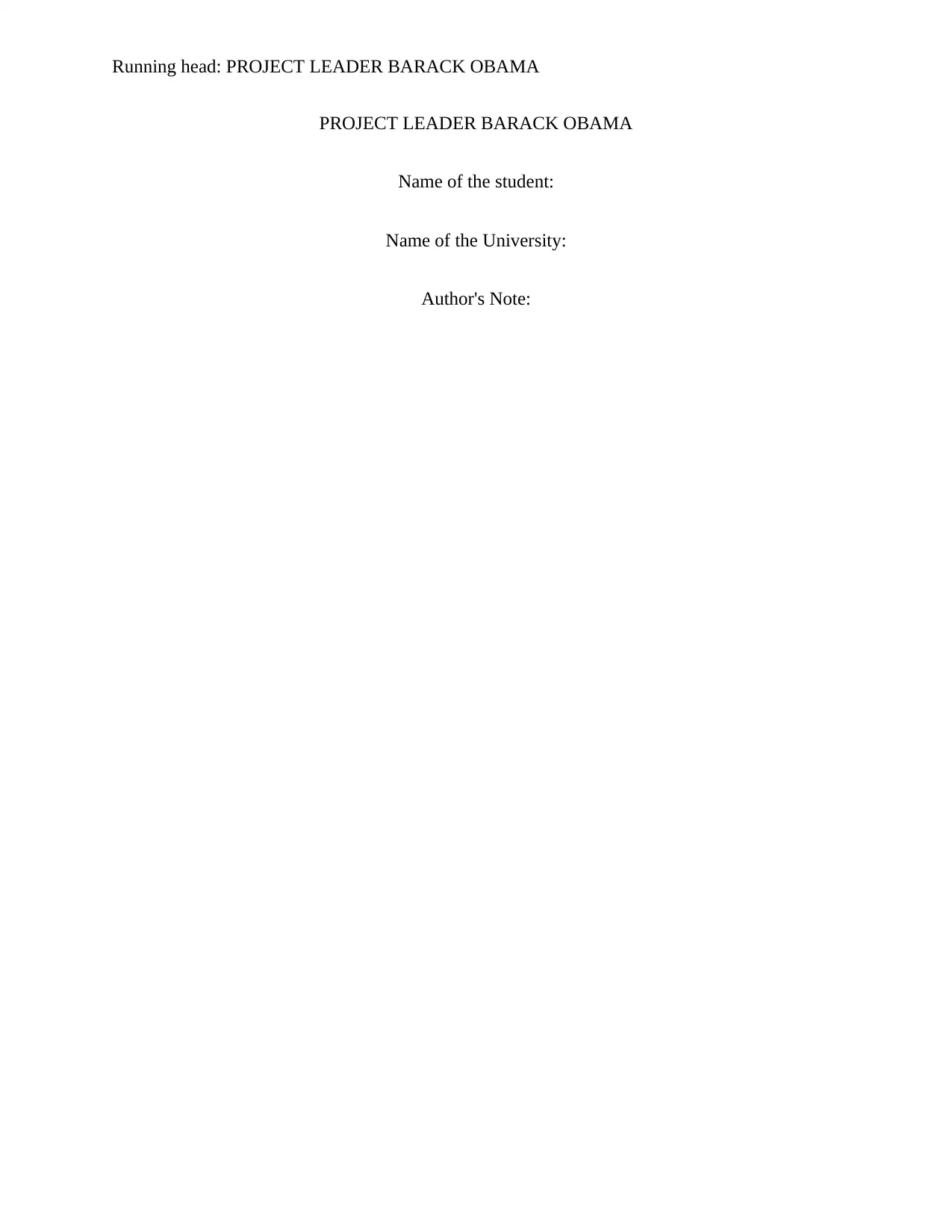
Running head: PROJECT LEADER BARACK OBAMA
PROJECT LEADER BARACK OBAMA
Name of the student:
Name of the University:
Author's Note:
PROJECT LEADER BARACK OBAMA
Name of the student:
Name of the University:
Author's Note:
Paraphrase This Document
Need a fresh take? Get an instant paraphrase of this document with our AI Paraphraser

1PROJECT LEADER BARACK OBAMA
Executive summary
The aim of this report is to discuss the project management ability of one of the most
important global leaders, Barack Obama who served the presidential responsibilities of the USA
for twice. This report has analyzed the background of this popular leader and his style of
leadership in detail. The behaviors of this particular leader have been outlined through
transformational leadership theory. Obama bears the characteristics of a charismatic leader who
through his personality traits manipulate the followers. He is effective communicator, decision
maker and risk taker. In order to implement the changes in the health care system of the country
he initiated the project name Obamacare that brought all the people of the country under the
insurance coverage and benefitted in terms of treatment. This paper has detailed his traits as a
leader and success of his project effectively.
Executive summary
The aim of this report is to discuss the project management ability of one of the most
important global leaders, Barack Obama who served the presidential responsibilities of the USA
for twice. This report has analyzed the background of this popular leader and his style of
leadership in detail. The behaviors of this particular leader have been outlined through
transformational leadership theory. Obama bears the characteristics of a charismatic leader who
through his personality traits manipulate the followers. He is effective communicator, decision
maker and risk taker. In order to implement the changes in the health care system of the country
he initiated the project name Obamacare that brought all the people of the country under the
insurance coverage and benefitted in terms of treatment. This paper has detailed his traits as a
leader and success of his project effectively.
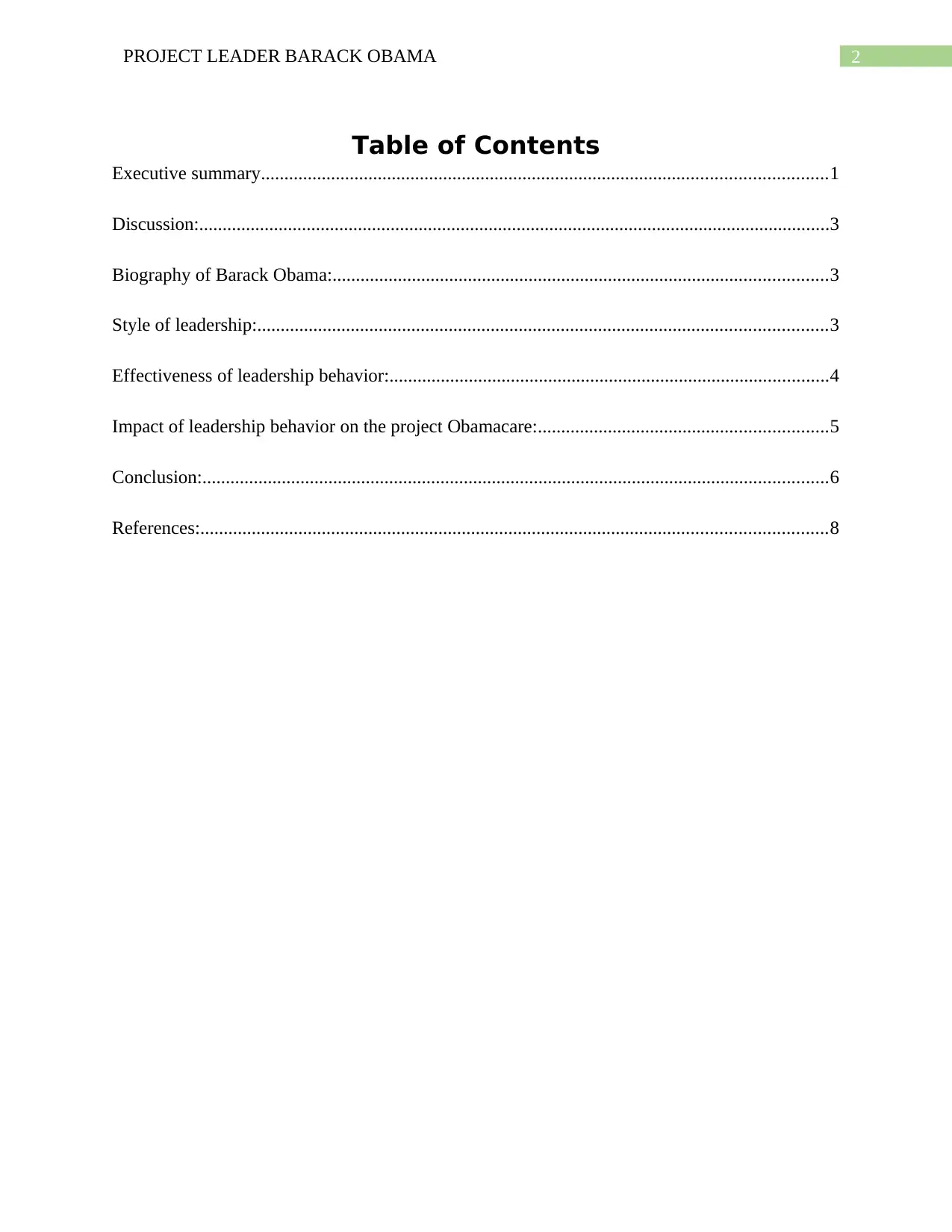
2PROJECT LEADER BARACK OBAMA
Table of Contents
Executive summary.........................................................................................................................1
Discussion:.......................................................................................................................................3
Biography of Barack Obama:..........................................................................................................3
Style of leadership:..........................................................................................................................3
Effectiveness of leadership behavior:..............................................................................................4
Impact of leadership behavior on the project Obamacare:..............................................................5
Conclusion:......................................................................................................................................6
References:......................................................................................................................................8
Table of Contents
Executive summary.........................................................................................................................1
Discussion:.......................................................................................................................................3
Biography of Barack Obama:..........................................................................................................3
Style of leadership:..........................................................................................................................3
Effectiveness of leadership behavior:..............................................................................................4
Impact of leadership behavior on the project Obamacare:..............................................................5
Conclusion:......................................................................................................................................6
References:......................................................................................................................................8
⊘ This is a preview!⊘
Do you want full access?
Subscribe today to unlock all pages.

Trusted by 1+ million students worldwide
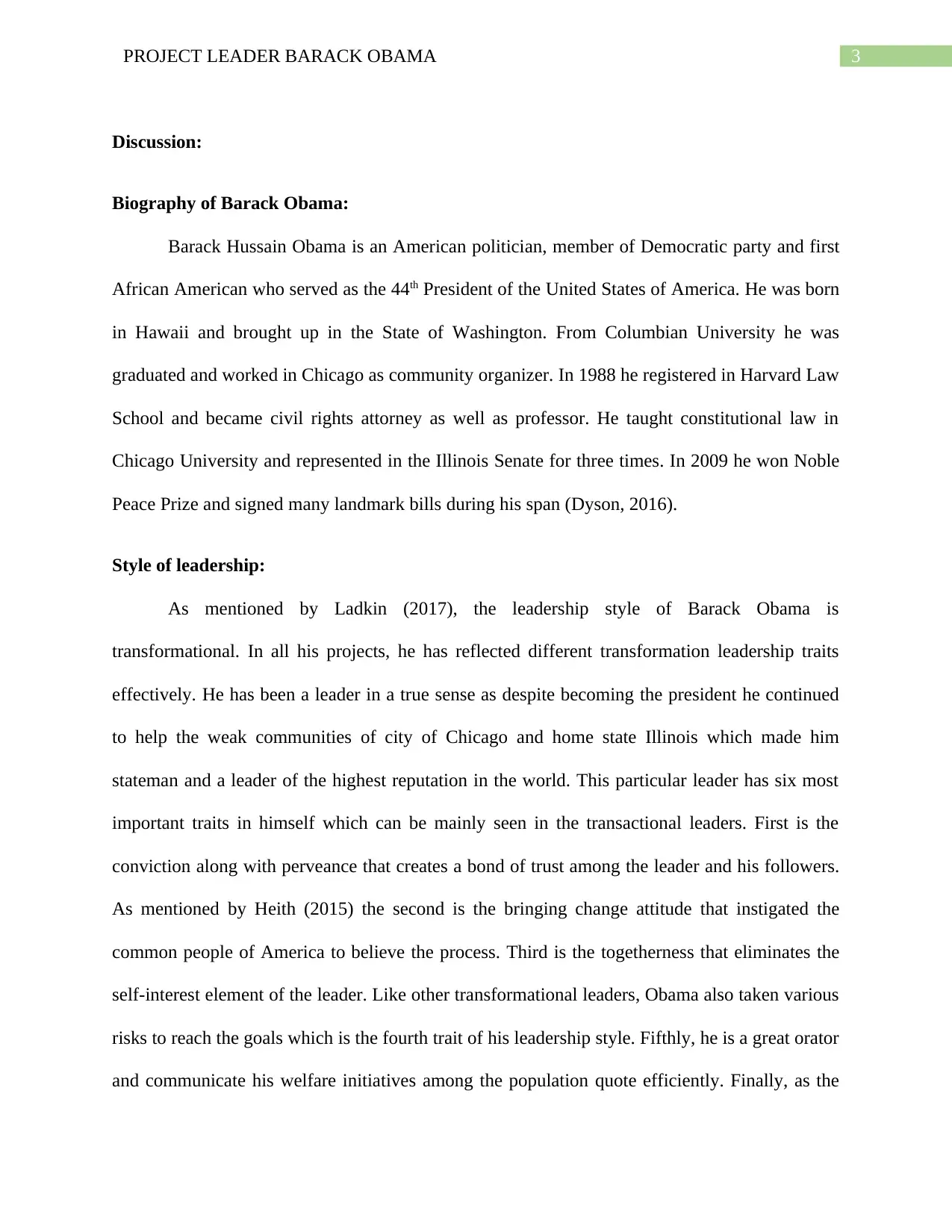
3PROJECT LEADER BARACK OBAMA
Discussion:
Biography of Barack Obama:
Barack Hussain Obama is an American politician, member of Democratic party and first
African American who served as the 44th President of the United States of America. He was born
in Hawaii and brought up in the State of Washington. From Columbian University he was
graduated and worked in Chicago as community organizer. In 1988 he registered in Harvard Law
School and became civil rights attorney as well as professor. He taught constitutional law in
Chicago University and represented in the Illinois Senate for three times. In 2009 he won Noble
Peace Prize and signed many landmark bills during his span (Dyson, 2016).
Style of leadership:
As mentioned by Ladkin (2017), the leadership style of Barack Obama is
transformational. In all his projects, he has reflected different transformation leadership traits
effectively. He has been a leader in a true sense as despite becoming the president he continued
to help the weak communities of city of Chicago and home state Illinois which made him
stateman and a leader of the highest reputation in the world. This particular leader has six most
important traits in himself which can be mainly seen in the transactional leaders. First is the
conviction along with perveance that creates a bond of trust among the leader and his followers.
As mentioned by Heith (2015) the second is the bringing change attitude that instigated the
common people of America to believe the process. Third is the togetherness that eliminates the
self-interest element of the leader. Like other transformational leaders, Obama also taken various
risks to reach the goals which is the fourth trait of his leadership style. Fifthly, he is a great orator
and communicate his welfare initiatives among the population quote efficiently. Finally, as the
Discussion:
Biography of Barack Obama:
Barack Hussain Obama is an American politician, member of Democratic party and first
African American who served as the 44th President of the United States of America. He was born
in Hawaii and brought up in the State of Washington. From Columbian University he was
graduated and worked in Chicago as community organizer. In 1988 he registered in Harvard Law
School and became civil rights attorney as well as professor. He taught constitutional law in
Chicago University and represented in the Illinois Senate for three times. In 2009 he won Noble
Peace Prize and signed many landmark bills during his span (Dyson, 2016).
Style of leadership:
As mentioned by Ladkin (2017), the leadership style of Barack Obama is
transformational. In all his projects, he has reflected different transformation leadership traits
effectively. He has been a leader in a true sense as despite becoming the president he continued
to help the weak communities of city of Chicago and home state Illinois which made him
stateman and a leader of the highest reputation in the world. This particular leader has six most
important traits in himself which can be mainly seen in the transactional leaders. First is the
conviction along with perveance that creates a bond of trust among the leader and his followers.
As mentioned by Heith (2015) the second is the bringing change attitude that instigated the
common people of America to believe the process. Third is the togetherness that eliminates the
self-interest element of the leader. Like other transformational leaders, Obama also taken various
risks to reach the goals which is the fourth trait of his leadership style. Fifthly, he is a great orator
and communicate his welfare initiatives among the population quote efficiently. Finally, as the
Paraphrase This Document
Need a fresh take? Get an instant paraphrase of this document with our AI Paraphraser
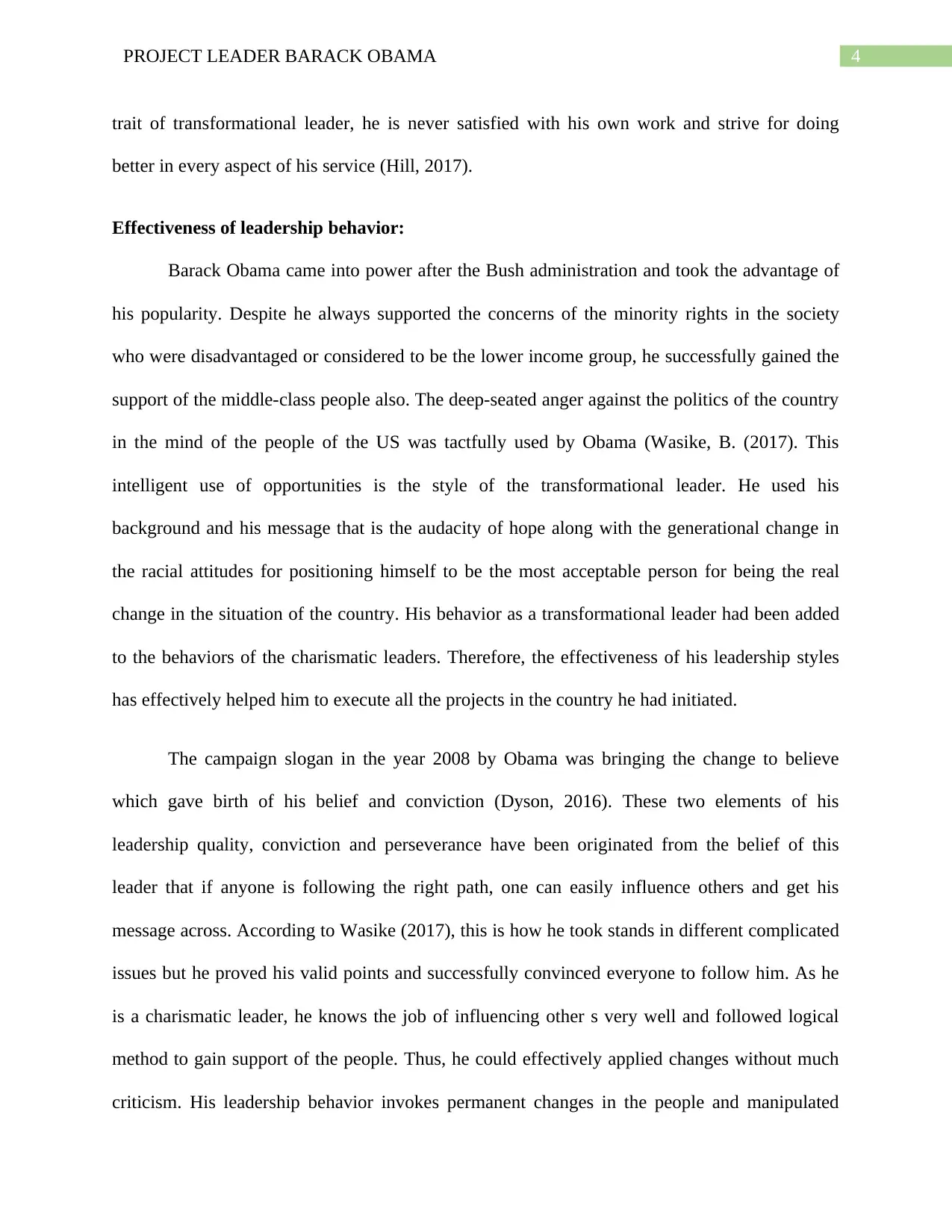
4PROJECT LEADER BARACK OBAMA
trait of transformational leader, he is never satisfied with his own work and strive for doing
better in every aspect of his service (Hill, 2017).
Effectiveness of leadership behavior:
Barack Obama came into power after the Bush administration and took the advantage of
his popularity. Despite he always supported the concerns of the minority rights in the society
who were disadvantaged or considered to be the lower income group, he successfully gained the
support of the middle-class people also. The deep-seated anger against the politics of the country
in the mind of the people of the US was tactfully used by Obama (Wasike, B. (2017). This
intelligent use of opportunities is the style of the transformational leader. He used his
background and his message that is the audacity of hope along with the generational change in
the racial attitudes for positioning himself to be the most acceptable person for being the real
change in the situation of the country. His behavior as a transformational leader had been added
to the behaviors of the charismatic leaders. Therefore, the effectiveness of his leadership styles
has effectively helped him to execute all the projects in the country he had initiated.
The campaign slogan in the year 2008 by Obama was bringing the change to believe
which gave birth of his belief and conviction (Dyson, 2016). These two elements of his
leadership quality, conviction and perseverance have been originated from the belief of this
leader that if anyone is following the right path, one can easily influence others and get his
message across. According to Wasike (2017), this is how he took stands in different complicated
issues but he proved his valid points and successfully convinced everyone to follow him. As he
is a charismatic leader, he knows the job of influencing other s very well and followed logical
method to gain support of the people. Thus, he could effectively applied changes without much
criticism. His leadership behavior invokes permanent changes in the people and manipulated
trait of transformational leader, he is never satisfied with his own work and strive for doing
better in every aspect of his service (Hill, 2017).
Effectiveness of leadership behavior:
Barack Obama came into power after the Bush administration and took the advantage of
his popularity. Despite he always supported the concerns of the minority rights in the society
who were disadvantaged or considered to be the lower income group, he successfully gained the
support of the middle-class people also. The deep-seated anger against the politics of the country
in the mind of the people of the US was tactfully used by Obama (Wasike, B. (2017). This
intelligent use of opportunities is the style of the transformational leader. He used his
background and his message that is the audacity of hope along with the generational change in
the racial attitudes for positioning himself to be the most acceptable person for being the real
change in the situation of the country. His behavior as a transformational leader had been added
to the behaviors of the charismatic leaders. Therefore, the effectiveness of his leadership styles
has effectively helped him to execute all the projects in the country he had initiated.
The campaign slogan in the year 2008 by Obama was bringing the change to believe
which gave birth of his belief and conviction (Dyson, 2016). These two elements of his
leadership quality, conviction and perseverance have been originated from the belief of this
leader that if anyone is following the right path, one can easily influence others and get his
message across. According to Wasike (2017), this is how he took stands in different complicated
issues but he proved his valid points and successfully convinced everyone to follow him. As he
is a charismatic leader, he knows the job of influencing other s very well and followed logical
method to gain support of the people. Thus, he could effectively applied changes without much
criticism. His leadership behavior invokes permanent changes in the people and manipulated
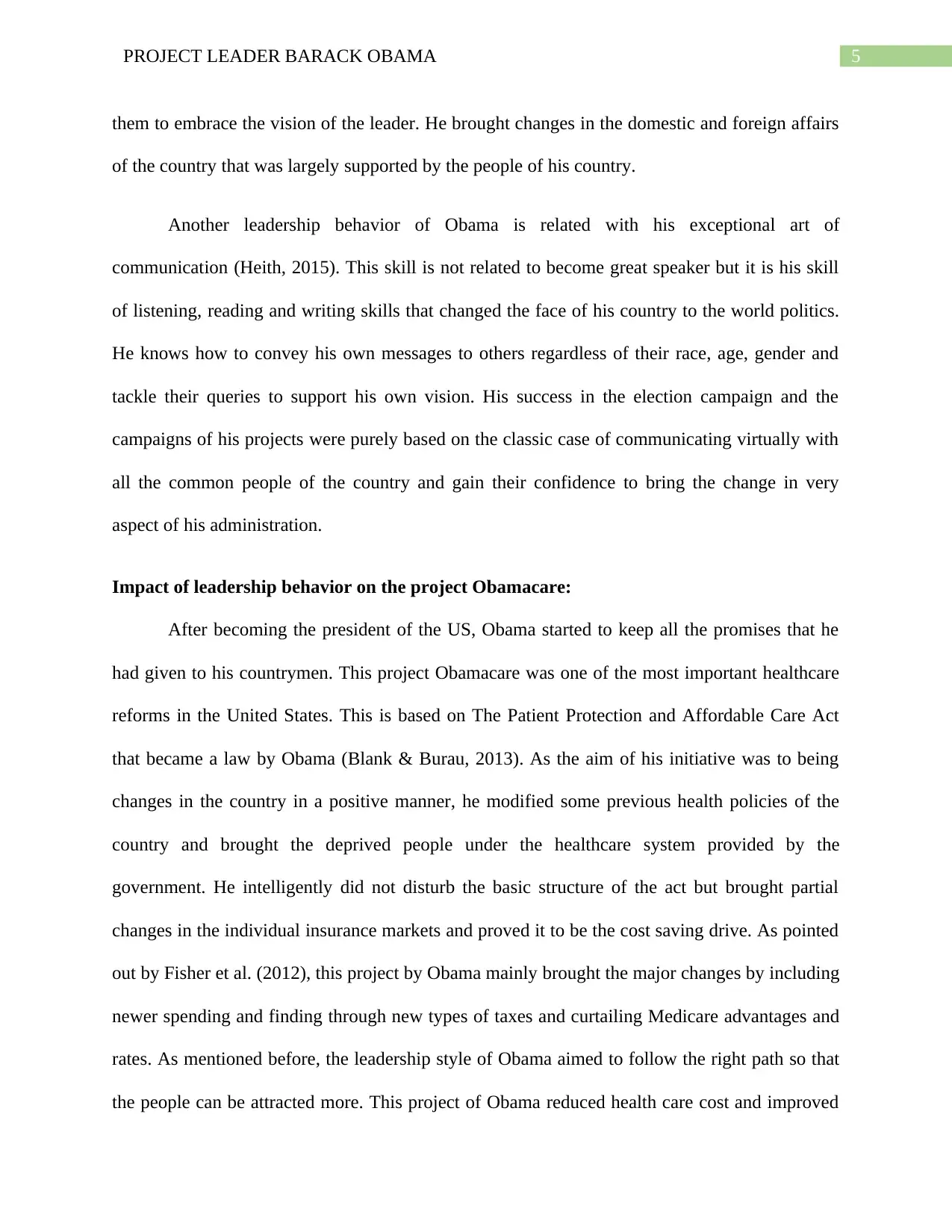
5PROJECT LEADER BARACK OBAMA
them to embrace the vision of the leader. He brought changes in the domestic and foreign affairs
of the country that was largely supported by the people of his country.
Another leadership behavior of Obama is related with his exceptional art of
communication (Heith, 2015). This skill is not related to become great speaker but it is his skill
of listening, reading and writing skills that changed the face of his country to the world politics.
He knows how to convey his own messages to others regardless of their race, age, gender and
tackle their queries to support his own vision. His success in the election campaign and the
campaigns of his projects were purely based on the classic case of communicating virtually with
all the common people of the country and gain their confidence to bring the change in very
aspect of his administration.
Impact of leadership behavior on the project Obamacare:
After becoming the president of the US, Obama started to keep all the promises that he
had given to his countrymen. This project Obamacare was one of the most important healthcare
reforms in the United States. This is based on The Patient Protection and Affordable Care Act
that became a law by Obama (Blank & Burau, 2013). As the aim of his initiative was to being
changes in the country in a positive manner, he modified some previous health policies of the
country and brought the deprived people under the healthcare system provided by the
government. He intelligently did not disturb the basic structure of the act but brought partial
changes in the individual insurance markets and proved it to be the cost saving drive. As pointed
out by Fisher et al. (2012), this project by Obama mainly brought the major changes by including
newer spending and finding through new types of taxes and curtailing Medicare advantages and
rates. As mentioned before, the leadership style of Obama aimed to follow the right path so that
the people can be attracted more. This project of Obama reduced health care cost and improved
them to embrace the vision of the leader. He brought changes in the domestic and foreign affairs
of the country that was largely supported by the people of his country.
Another leadership behavior of Obama is related with his exceptional art of
communication (Heith, 2015). This skill is not related to become great speaker but it is his skill
of listening, reading and writing skills that changed the face of his country to the world politics.
He knows how to convey his own messages to others regardless of their race, age, gender and
tackle their queries to support his own vision. His success in the election campaign and the
campaigns of his projects were purely based on the classic case of communicating virtually with
all the common people of the country and gain their confidence to bring the change in very
aspect of his administration.
Impact of leadership behavior on the project Obamacare:
After becoming the president of the US, Obama started to keep all the promises that he
had given to his countrymen. This project Obamacare was one of the most important healthcare
reforms in the United States. This is based on The Patient Protection and Affordable Care Act
that became a law by Obama (Blank & Burau, 2013). As the aim of his initiative was to being
changes in the country in a positive manner, he modified some previous health policies of the
country and brought the deprived people under the healthcare system provided by the
government. He intelligently did not disturb the basic structure of the act but brought partial
changes in the individual insurance markets and proved it to be the cost saving drive. As pointed
out by Fisher et al. (2012), this project by Obama mainly brought the major changes by including
newer spending and finding through new types of taxes and curtailing Medicare advantages and
rates. As mentioned before, the leadership style of Obama aimed to follow the right path so that
the people can be attracted more. This project of Obama reduced health care cost and improved
⊘ This is a preview!⊘
Do you want full access?
Subscribe today to unlock all pages.

Trusted by 1+ million students worldwide
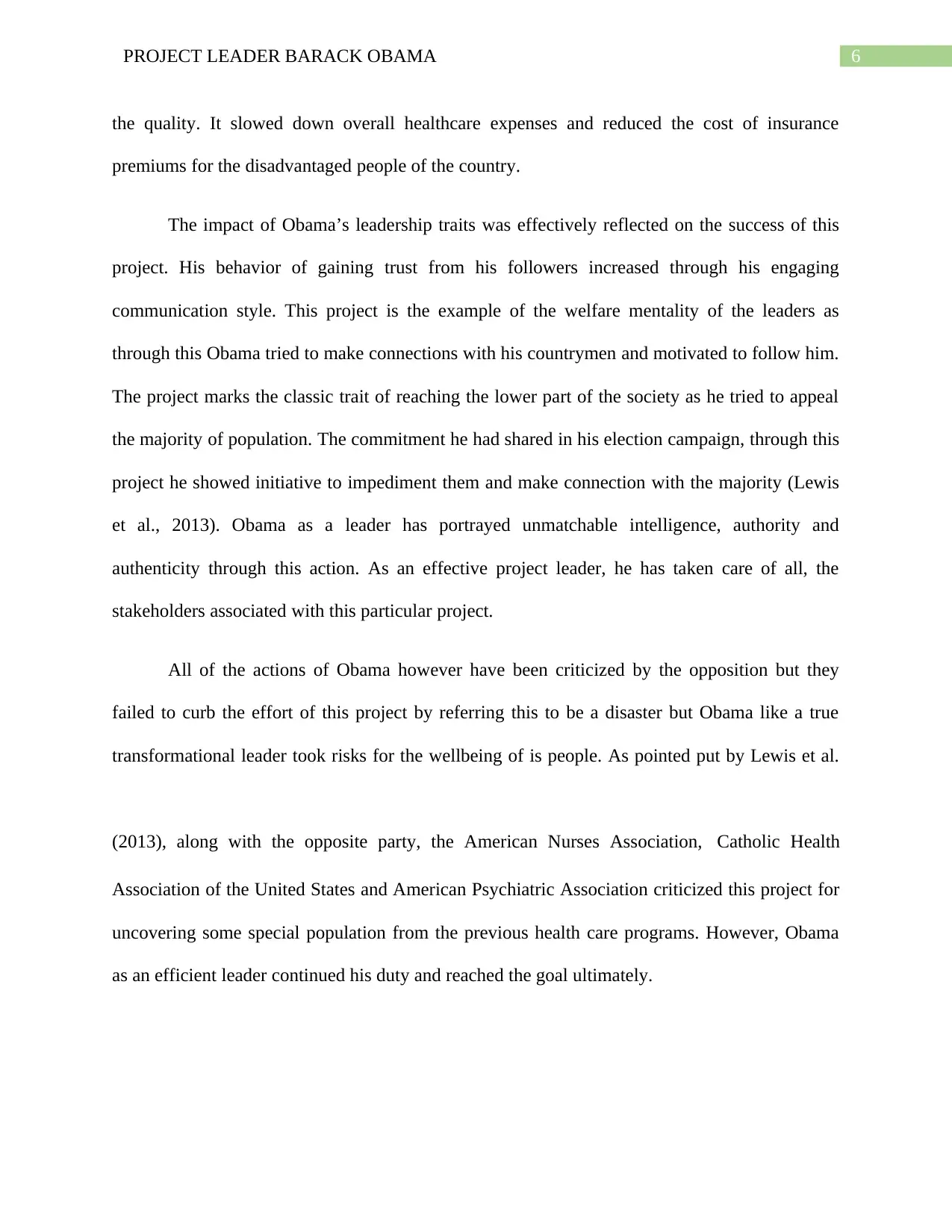
6PROJECT LEADER BARACK OBAMA
the quality. It slowed down overall healthcare expenses and reduced the cost of insurance
premiums for the disadvantaged people of the country.
The impact of Obama’s leadership traits was effectively reflected on the success of this
project. His behavior of gaining trust from his followers increased through his engaging
communication style. This project is the example of the welfare mentality of the leaders as
through this Obama tried to make connections with his countrymen and motivated to follow him.
The project marks the classic trait of reaching the lower part of the society as he tried to appeal
the majority of population. The commitment he had shared in his election campaign, through this
project he showed initiative to impediment them and make connection with the majority (Lewis
et al., 2013). Obama as a leader has portrayed unmatchable intelligence, authority and
authenticity through this action. As an effective project leader, he has taken care of all, the
stakeholders associated with this particular project.
All of the actions of Obama however have been criticized by the opposition but they
failed to curb the effort of this project by referring this to be a disaster but Obama like a true
transformational leader took risks for the wellbeing of is people. As pointed put by Lewis et al.
(2013), along with the opposite party, the American Nurses Association, Catholic Health
Association of the United States and American Psychiatric Association criticized this project for
uncovering some special population from the previous health care programs. However, Obama
as an efficient leader continued his duty and reached the goal ultimately.
the quality. It slowed down overall healthcare expenses and reduced the cost of insurance
premiums for the disadvantaged people of the country.
The impact of Obama’s leadership traits was effectively reflected on the success of this
project. His behavior of gaining trust from his followers increased through his engaging
communication style. This project is the example of the welfare mentality of the leaders as
through this Obama tried to make connections with his countrymen and motivated to follow him.
The project marks the classic trait of reaching the lower part of the society as he tried to appeal
the majority of population. The commitment he had shared in his election campaign, through this
project he showed initiative to impediment them and make connection with the majority (Lewis
et al., 2013). Obama as a leader has portrayed unmatchable intelligence, authority and
authenticity through this action. As an effective project leader, he has taken care of all, the
stakeholders associated with this particular project.
All of the actions of Obama however have been criticized by the opposition but they
failed to curb the effort of this project by referring this to be a disaster but Obama like a true
transformational leader took risks for the wellbeing of is people. As pointed put by Lewis et al.
(2013), along with the opposite party, the American Nurses Association, Catholic Health
Association of the United States and American Psychiatric Association criticized this project for
uncovering some special population from the previous health care programs. However, Obama
as an efficient leader continued his duty and reached the goal ultimately.
Paraphrase This Document
Need a fresh take? Get an instant paraphrase of this document with our AI Paraphraser

7PROJECT LEADER BARACK OBAMA
Conclusion:
Therefore, it can be concluded that Obama is an efficient leader in the politics of the
world who not only took care of the party intertest but worked to support the wellbeing of the
people of America during his period of service. He is a transformational leader who gained the
support of majority of Americans for his exceptional leadership capabilities. He is a visionary,
communicators, risk taker and he ultimate decision maker who always tried to follow the right
path. His ability to make decisions to complete his commitments before election and welfare
mentality brought immense popularity for him. This is not only limited to the country only but he
had admirers across the globe. He represented the first Afro-American president in the history of
America.
Conclusion:
Therefore, it can be concluded that Obama is an efficient leader in the politics of the
world who not only took care of the party intertest but worked to support the wellbeing of the
people of America during his period of service. He is a transformational leader who gained the
support of majority of Americans for his exceptional leadership capabilities. He is a visionary,
communicators, risk taker and he ultimate decision maker who always tried to follow the right
path. His ability to make decisions to complete his commitments before election and welfare
mentality brought immense popularity for him. This is not only limited to the country only but he
had admirers across the globe. He represented the first Afro-American president in the history of
America.
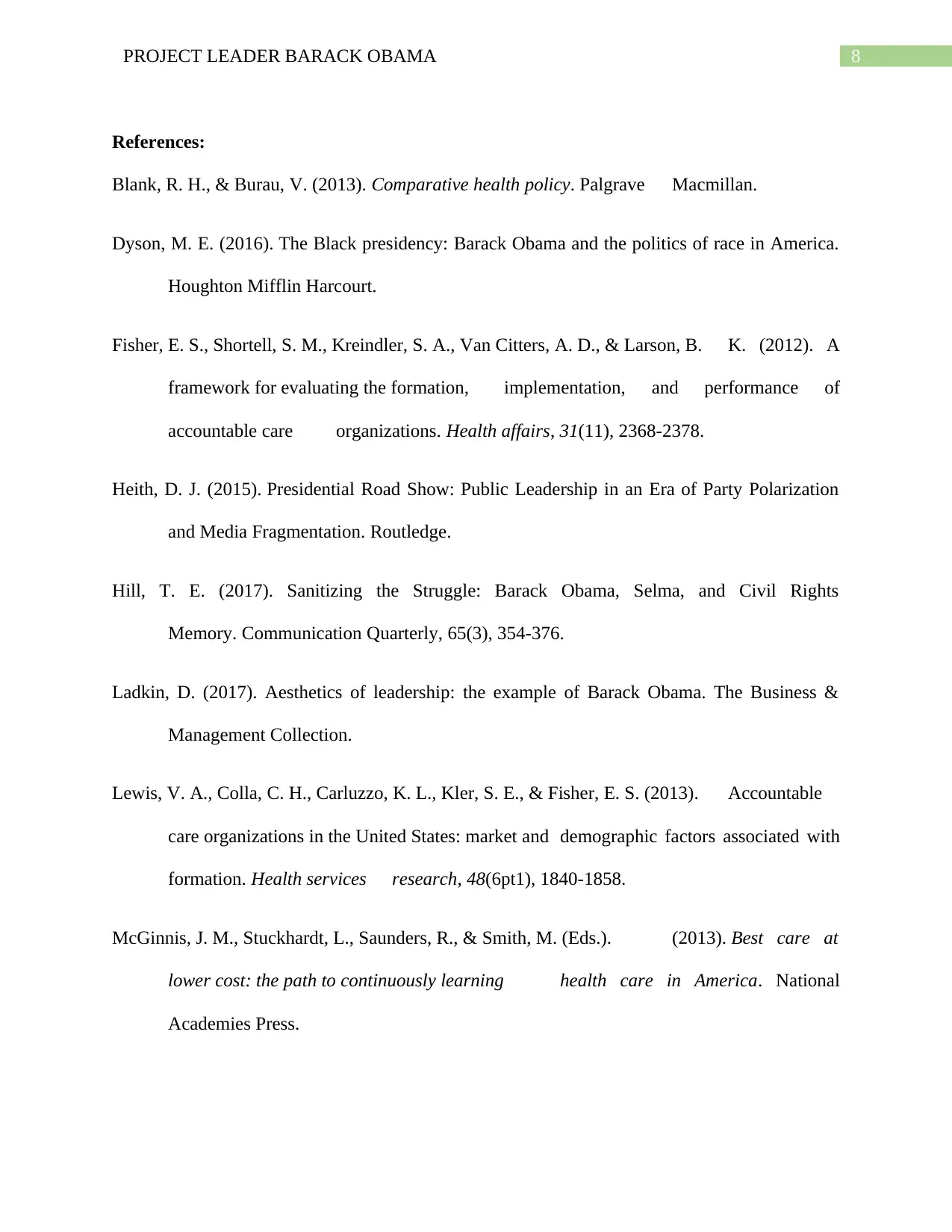
8PROJECT LEADER BARACK OBAMA
References:
Blank, R. H., & Burau, V. (2013). Comparative health policy. Palgrave Macmillan.
Dyson, M. E. (2016). The Black presidency: Barack Obama and the politics of race in America.
Houghton Mifflin Harcourt.
Fisher, E. S., Shortell, S. M., Kreindler, S. A., Van Citters, A. D., & Larson, B. K. (2012). A
framework for evaluating the formation, implementation, and performance of
accountable care organizations. Health affairs, 31(11), 2368-2378.
Heith, D. J. (2015). Presidential Road Show: Public Leadership in an Era of Party Polarization
and Media Fragmentation. Routledge.
Hill, T. E. (2017). Sanitizing the Struggle: Barack Obama, Selma, and Civil Rights
Memory. Communication Quarterly, 65(3), 354-376.
Ladkin, D. (2017). Aesthetics of leadership: the example of Barack Obama. The Business &
Management Collection.
Lewis, V. A., Colla, C. H., Carluzzo, K. L., Kler, S. E., & Fisher, E. S. (2013). Accountable
care organizations in the United States: market and demographic factors associated with
formation. Health services research, 48(6pt1), 1840-1858.
McGinnis, J. M., Stuckhardt, L., Saunders, R., & Smith, M. (Eds.). (2013). Best care at
lower cost: the path to continuously learning health care in America. National
Academies Press.
References:
Blank, R. H., & Burau, V. (2013). Comparative health policy. Palgrave Macmillan.
Dyson, M. E. (2016). The Black presidency: Barack Obama and the politics of race in America.
Houghton Mifflin Harcourt.
Fisher, E. S., Shortell, S. M., Kreindler, S. A., Van Citters, A. D., & Larson, B. K. (2012). A
framework for evaluating the formation, implementation, and performance of
accountable care organizations. Health affairs, 31(11), 2368-2378.
Heith, D. J. (2015). Presidential Road Show: Public Leadership in an Era of Party Polarization
and Media Fragmentation. Routledge.
Hill, T. E. (2017). Sanitizing the Struggle: Barack Obama, Selma, and Civil Rights
Memory. Communication Quarterly, 65(3), 354-376.
Ladkin, D. (2017). Aesthetics of leadership: the example of Barack Obama. The Business &
Management Collection.
Lewis, V. A., Colla, C. H., Carluzzo, K. L., Kler, S. E., & Fisher, E. S. (2013). Accountable
care organizations in the United States: market and demographic factors associated with
formation. Health services research, 48(6pt1), 1840-1858.
McGinnis, J. M., Stuckhardt, L., Saunders, R., & Smith, M. (Eds.). (2013). Best care at
lower cost: the path to continuously learning health care in America. National
Academies Press.
⊘ This is a preview!⊘
Do you want full access?
Subscribe today to unlock all pages.

Trusted by 1+ million students worldwide

9PROJECT LEADER BARACK OBAMA
Wasike, B. (2017). Charismatic rhetoric, integrative complexity and the US Presidency: An
analysis of the State of the Union Address (SOTU) from George Washington to Barack
Obama. The Leadership Quarterly, 28(6), 812-826.
Wasike, B. (2017). Charismatic rhetoric, integrative complexity and the US Presidency: An
analysis of the State of the Union Address (SOTU) from George Washington to Barack
Obama. The Leadership Quarterly, 28(6), 812-826.
1 out of 10
Related Documents
Your All-in-One AI-Powered Toolkit for Academic Success.
+13062052269
info@desklib.com
Available 24*7 on WhatsApp / Email
![[object Object]](/_next/static/media/star-bottom.7253800d.svg)
Unlock your academic potential
Copyright © 2020–2025 A2Z Services. All Rights Reserved. Developed and managed by ZUCOL.




